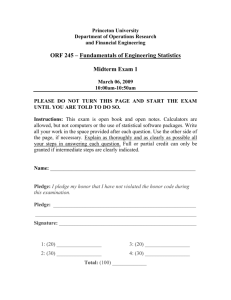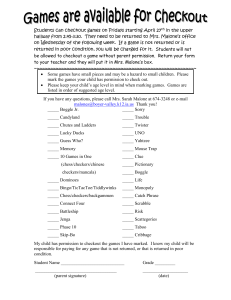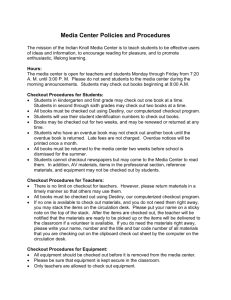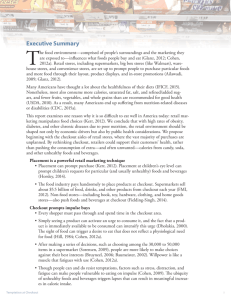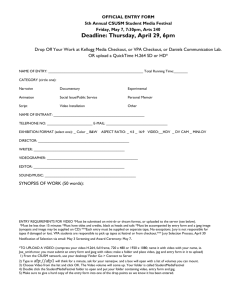The Model Healthy Checkout Ordinance
advertisement
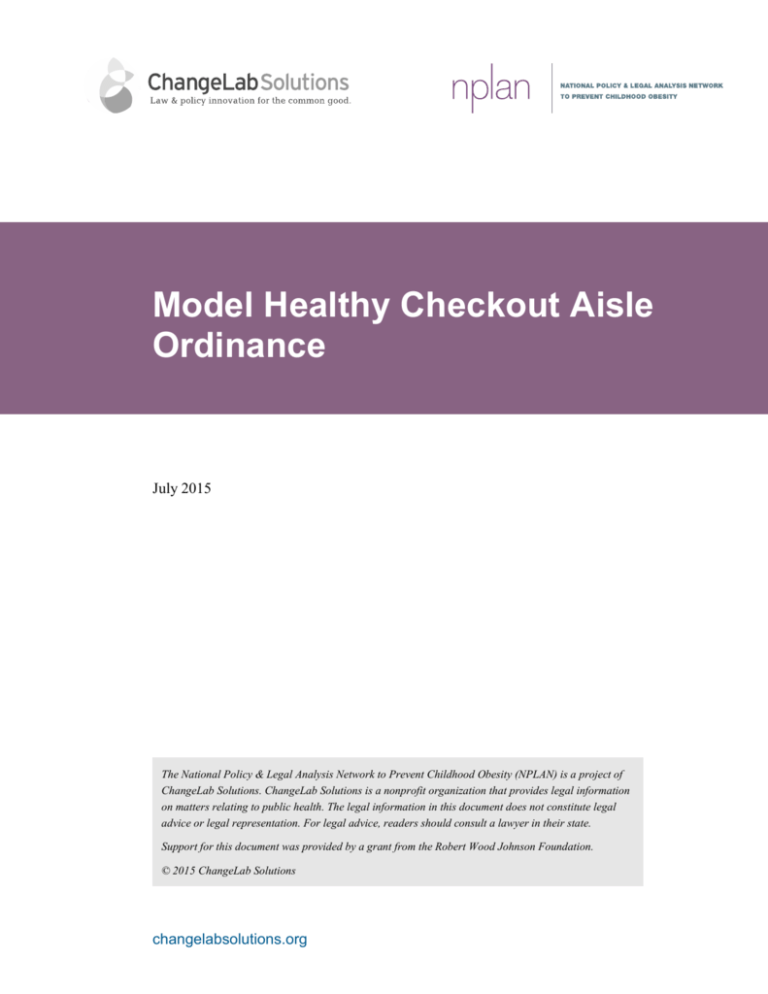
Model Healthy Checkout Aisle Ordinance July 2015 The National Policy & Legal Analysis Network to Prevent Childhood Obesity (NPLAN) is a project of ChangeLab Solutions. ChangeLab Solutions is a nonprofit organization that provides legal information on matters relating to public health. The legal information in this document does not constitute legal advice or legal representation. For legal advice, readers should consult a lawyer in their state. Support for this document was provided by a grant from the Robert Wood Johnson Foundation. © 2015 ChangeLab Solutions changelabsolutions.org Introduction Today, one-third of American children and adolescents are obese or overweight.1 Obese children are at least twice as likely as non-obese children to become obese adults2 and are at increased risk for serious health problems in adulthood, including heart disease, type 2 diabetes, asthma, and cancer.3 A 2012 study estimated that the annual medical costs of obesity in the United States are $190 billion.4 Medicare and Medicaid pay for more than 40 percent of these obesity-related costs, so taxpayers foot a significant portion of the bill.5 Many Americans want to purchase and eat healthier foods,6 but the proliferation of unhealthy foods at all types of retail stores can make it difficult for people to make healthy choices. Research increasingly shows that our food choices are strongly affected by the environments in which they are made. A particular problem is the unhealthy foods and beverages available to consumers while they wait in line to purchase items in stores.7 The placement of snack foods near the cash register increases the likelihood that people will purchase those foods.8 In addition, most of the candy, soda, and chips in checkout aisles are placed at the eye level and within reach of children, providing them with a cue to eat and posing a challenge for the adults who take care of them.9 The amount of unhealthy foods at checkout is overwhelming. A recent study examining 8,617 stores – including supermarkets, convenience stores, drug stores, and dollar stores – in 468 communities found that 88 percent display candy at checkout and more than one-third (34%) sell sugar-sweetened beverages.10 Only 24 percent of the stores sell water at checkout, and only 13 percent sell fresh fruits or vegetables.10 Almost all supermarkets (91%) display candy at checkout, and 85 percent sell soda and other sugary drinks at checkout.10 Most retailers are more likely to sell sugary drinks than water at checkout.10 Another study found that a wide variety of stores – including many not in the business of selling food – sell sugary drinks and candy at checkout. In those establishments, 60 percent of beverage offerings are soda, energy drinks, sports drinks, and other sugary drinks, and 90 percent of food offerings are unhealthy (including candy, chips, and similar snacks).11 The Model Healthy Checkout Ordinance One solution to this problem is to remove prompts that induce customers to buy things impulsively while they wait in the checkout line. Replacing unhealthy foods with healthier options and other non-food alternatives is one way to help families make healthier choices. Several communities have successfully implemented this approach. Middle school students in Anderson, California, a small city in northern Shasta County, asked their local Wal-Mart to place healthier foods in the checkout aisle.12 The two pilot checkout aisles were so successful and had such overwhelming customer support that the store expanded the program to additional aisles.12 Similarly, in the Mid-Ohio Valley in West Virginia, three Wal-Marts and Model Healthy Checkout Aisle Ordinance changelabsolutions.org 2 five Foodland grocery stores implemented healthy checkout aisles.13 Both store management and customers provided positive feedback, and the stores often needed to restock healthy items during the day because they sold so well.13,14 Additionally, in the United Kingdom, three major retail chains have replaced candy with healthier options in all their checkout aisles.15,16 This model ordinance requires all retail stores to provide healthy checkout aisles for consumers. It offers two options for determining what foods may be sold in checkout aisles. One option is to provide a specific list of foods that may be available in checkout lanes; the other provides nutrition-based criteria for determining what foods and beverages may be available. The nutrition standards are based on the National Alliance for Nutrition and Activity’s (NANA) vending standards. NANA is a coalition of more than 450 national, state, and local health and education organizations.17 Enacting the Policy Most local governments have the authority to regulate aspects of retail operations through zoning and other “police power" measures (measures to protect the health, safety, and welfare of the community). It is important to consult both state law to determine whether the local government has the police power to regulate retail operations and the state’s retail food code to determine whether it contains provisions that prohibit local regulation of food establishments. These laws could preempt or prohibit local regulation of the same subject matter. Though designed as a local ordinance, the model can be adapted for other uses. For instance, it could be enacted as a state law, and in some states, a state or local board of health may be able to implement the policy. Cities and counties could also pass a resolution urging retail stores to provide healthy checkout aisles, or they could require healthy checkout aisles as part of a healthy retail initiative. Finally, retailers, local chambers of commerce, or other business associations could choose to implement healthy checkout aisles voluntarily. The language in the model ordinance is designed to be tailored to the needs of an individual community. The language written in italics provides different options or explains the type of information that needs to be inserted in the blank spaces. The “comments” provide additional information and explanation. In considering which options to choose, the community should balance public health benefits against practical and political considerations in the particular jurisdiction. One purpose of including a variety of options is to stimulate broad thinking about the types of provisions a community might wish to explore, even beyond those described in the model. ChangeLab Solutions is interested in learning about novel provisions that communities are considering; the best way to contact us is through our website: www.changelabsolutions.org. An appendix (“Appendix: Enforcement Provisions”) accompanies this model, outlining a range of enforcement options. Though options vary according to local law and custom, enforcement clauses are an important component of any ordinance. Model Healthy Checkout Aisle Ordinance changelabsolutions.org 3 ORDINANCE OF THE [ Municipality (e.g., City of _____) ] REQUIRING HEALTHY CHECKOUT AISLES AND AMENDING THE [ Municipality ] MUNICIPAL CODE SECTION I. FINDINGS. The [ Municipality ] hereby finds and declares as follows: a. Over the past 30 years, the obesity rate in the United States has more than doubled. According to the Centers for Disease Control and Prevention (CDC), two-thirds (68.5%) of American adults are overweight or obese.1 In [insert the year of the most recently available information] in [insert name of state/local jurisdiction], [insert state or local jurisdiction’s obese adult population percentage here] of adult residents were overweight or obese. About one-third of children nationwide are overweight or obese.1 In [insert name of state or locality], [insert state or locality’s obese youth population percentage here] of children are overweight or obese. COMMENT: The CDC reports the prevalence of adult obesity by state and territory here: www.cdc.gov/obesity/data/table-adults.html. b. Obese children are at least twice as likely as non-obese children to become obese adults2 and are at increased risk for serious health problems in adulthood, including heart disease, type 2 diabetes, asthma, and cancer.3 c. Obesity-related health conditions have serious economic costs. Estimated annual health care costs from obesity are $190 billion4 – or 21 percent of total current health care spending – and are expected to rise substantially.18 Roughly 40 percent of these costs are paid through Medicare and Medicaid, which means that taxpayers foot a significant portion of the bill.5 Medicare and Medicaid spending would be reduced by 8.5 percent and 11.8 percent, respectively, in the absence of obesity-related spending.5 Obesity-related annual medical expenditures in [insert name of state] are estimated at [insert state’s cost of obesity here].1* d. In 2010, the U.S. Department of Agriculture reported the top sources of calories for American children. Grain-based desserts ranked number one; soda and other sugarsweetened beverages ranked number three; potato, corn, and other chips ranked number nine; and candy ranked number 13.19 e. Consumers are trying to make healthier purchases. A 2010 report found that 66 percent of shoppers say they are looking for ways to improve their health through the 1 * For state-specific health care spending data, see Finkelstein EA, Fiebelkorn IC, Wang G. State-Level Estimates of Annual Medical Expenditures Attributable to Obesity. Obesity Research. 2004;12(1):18-24. These state-level data are for 2003. State health agencies may have more recent spending data. Model Healthy Checkout Aisle Ordinance changelabsolutions.org 4 choices they make while grocery shopping, and 74 percent of shoppers say a top health concern is “managing or losing weight.”6 f. Despite consumers’ desires to select healthier foods, unhealthy foods are increasingly prevalent in checkout areas in a wide variety of retail stores. A recent national study of 8,617 stores – including supermarkets, convenience stores, drug stores, and dollar stores – in 468 communities found that 88 percent display candy at checkout and more than one-third (34%) sell sugar-sweetened beverages.10 Only 24 percent of the stores sell water at checkout, and only 13 percent sell fresh fruits or vegetables.10 Almost all supermarkets (91%) display candy at checkout, and 85 percent sell soda and other sugary drinks at checkout.10 g. Research increasingly shows that our food choices are strongly affected by the environments in which they are made. Therefore, making unhealthy foods and beverages available to consumers while they wait in checkout lines undermines consumers’ efforts to purchase healthier foods.7 The presence of snacks near the register increases the likelihood that people will purchase those foods.8 In addition, most of the candy, soda, and chips in checkout aisles are placed at the eye level and within reach of children, providing a particular temptation for them.9 h. [ Municipal Legislators (e.g., city council) ] intend, in adopting this ordinance, to support families by offering them the choice to avoid high-calorie, low-nutrient food when they do their grocery and other shopping. SECTION II. [ Chapter __] of the [ Municipality ] Municipal Code is hereby amended to read as follows: Sec. ___-1. Purpose. The purpose of this [ chapter ] is to support families by offering them the choice to avoid high-calorie, low-nutrient food when they do their grocery and other shopping. Sec. ___-2 Definitions. a. “Checkout area” means any area that is accessible to a customer of the Retail Store that is 1. within [ six ] feet of any Register; or COMMENT: While the area within six feet of the register is suggested, communities may want to tailor the area to meet local requirements. Some jurisdictions in urban areas, where store formats are typically smaller than those in other parts of the country, may wish to reduce the distance. Model Healthy Checkout Aisle Ordinance changelabsolutions.org 5 2. in an area where the Retail Store directs customers to wait in line to make a purchase. b. “Retail store” means a commercial establishment selling goods to the public. COMMENT: A recent study examining 8,617 stores – including supermarkets, convenience stores, drug stores, and dollar stores – in 468 communities found that 88 percent display candy at checkout and more than one-third (34%) sell sweetened beverages. Only 24 percent of the stores sell water at checkout, and only 13 percent sell fresh fruits or vegetables. Almost all supermarkets (91%) display candy at checkout and 85 percent sell soda and other sugary drinks at checkout. Most retailers are more likely to sell sugary drinks than water at checkout. Because unhealthy foods are sold at checkout in so many types of stores, the ordinance uses a very broad definition of retailer to ensure that the widest range of retailers is covered. Some jurisdictions may wish to define “retailer” more narrowly to focus on supermarkets or grocery stores. Jurisdictions may wish to use the definition of “food establishment” used in the state’s food retail code. Alternatively, the jurisdiction may want to use the definition of “retail store” used in its zoning code. c. “Register” means a cash register or similar device that calculates the sales of goods, holds money, and displays the amount of sales for the customer. Sec. ___-3. Healthy Checkout Areas. COMMENT: We offer communities two options to describe the types of foods and beverages that a retail store may sell in healthy checkout areas. Alternatively, communities can choose to create their own standards. Each retail store shall at all hours during which the retail store is open to the public ensure that [ insert either Option one or Option two ]. Option one: The only foods and beverages available in all checkout areas are fresh, canned, and dried fruits and vegetables without added sugars; nuts; sugar-free gum; and water. COMMENT: This option limits the foods and beverages that can be sold in healthy checkout areas to the specific items listed. Choosing this option will mean there are fewer types of products that can be offered at checkout, but may ease implementation for both the retailer and jurisdiction. It’s important to note that all foods and beverages available at the checkout area must comply with the same health and sanitation requirements that apply in other areas of the store. Model Healthy Checkout Aisle Ordinance changelabsolutions.org 6 Option two: The only foods and beverages available in all checkout areas are: a. Beverages consisting of: 1. Water, including carbonated water with no added caloric sweeteners 2. Coffee or tea with no added caloric sweeteners (permissible condiments include sugar, sugar substitutes, milk, and creamer products); 3. Fat-free or 1 percent low-fat dairy milk or calcium- and vitamin D-fortified soymilk with fewer than 200 calories per container; 4. 100 percent fruit juice or fruit juice combined with water or carbonated water, with no added caloric sweeteners, in a size no greater than 12 fluid ounces; 5. 100 percent vegetable juice with no added caloric sweeteners, no more than 200 milligrams of sodium per container, and in a size no greater than 12 fluid ounces; and 6. Low-calorie beverages that have no more than 40 calories per container. b. Foods that contain, per package: 1. No more than 200 calories; 2. No more than 35 percent of calories (or seven grams) from fat, with the exception of packages that contain 100 percent nuts or seeds; 3. No more than 10 percent of calories (or two grams) from saturated fat, with the exception of packages that contain 100 percent nuts or seeds; 4. Zero grams of trans fat; 5. No more than 35 percent of calories (or ten grams) from total sugars, with the exception of fruits and vegetables that do not contain added sweeteners or fats and yogurts that contain no more than 30 grams of total sugars per eight-ounce container; 6. No more than 200 milligrams of sodium; and 7. Meet at least one of the following standards: (A) Consist of sugar-free chewing gum; (B) Contain a quarter cup of fruit, non-fried vegetables, or fat-free/low-fat dairy; (C) Contain one ounce of nuts or seeds or one tablespoon of nut butter; (D) Contain at least 50 percent of the grain ingredients from whole grain, determined by the product listing whole grain as the first ingredient; or Model Healthy Checkout Aisle Ordinance changelabsolutions.org 7 (E) Contain 10 percent of the Daily Value (DV) of a naturally occurring nutrient of public health concern in the 2010 Dietary Guidelines for Americans (calcium, potassium, vitamin D, or dietary fiber). COMMENT: The nutrition standards listed in option two are from the National Alliance for Nutrition and Activity’s healthy vending standards. NANA is a coalition of more than 450 national, state, and local health and education organizations. The standards were developed by a committee of dietitians, local and state health departments, advocacy organizations, and national public health organizations. 2* This option allows a retailer to sell a broader array of foods and beverages than option one, but may be more cumbersome to implement. If a jurisdiction selects this option, it may wish to provide retailers with a list of approved products. Some products that meet the standards are listed here: www.cspinet.org/nutritionpolicy/Vending-Product-List.pdf Section ___4. Enforcement and Remedies. See APPENDIX: Enforcement Provisions COMMENT: A draft ordinance based on this model is not complete without including enforcement provisions. Realistic and meaningful enforcement is essential. An unenforceable law or a law with trivial penalties that are easily absorbed as the “cost of doing [illegal] business” can be worse than no law at all; an unenforced – or unenforceable – law undermines its effectiveness and the legitimacy of the municipality’s laws in general. Each municipality must consider its own practices and philosophy on enforcement – and state law – when choosing which options to include. Municipalities often include multiple options to provide maximum enforcement flexibility. A list of enforcement options that many municipalities will want to contemplate accompanies this model ordinance in “Appendix: Enforcement Provisions.” Section ___-5. Effective Date. The provisions of the Ordinance shall become effective on [ insert date up to six months from the enactment of the Ordinance ]. COMMENT: The enforcement agency, likely the department of health, will require time to educate local retail stores about the new law. Retail stores will also require time to conform their practices to the new law. Accordingly, we suggest that the municipality allow up to six months after enactment for the ordinance to be effective. 2 * The vending standards were approved by the NANA steering committee, consisting of representatives from the following organizations: Academy of Nutrition and Dietetics; American Alliance for Health, Physical Education, Recreation and Dance; American Cancer Society Cancer Action Network; American Diabetes Association; American Heart Association; American Public Health Association; Association of State Public Health Nutritionists; Center for Science in the Public Interest; National Association of Chronic Disease Directors; Nemours; and the United Fresh Produce Association. More information about NANA is available at: www.cspinet.org/nutritionpolicy/nana.html. Model Healthy Checkout Aisle Ordinance changelabsolutions.org 8 1. Ogden CL, Carroll MD, Kit BK, Flegal KM. Prevalence of childhood and adult obesity in the United States, 2011-2012. JAMA. 2014;311(8):806-814. doi:10.1001/jama.2014.732. 2. Serdula MK, Ivery D, Coates RJ, Freedman DS, Williamson DF, Byers T. Do Obese Children Become Obese Adults? A Review of the Literature. Prev Med (Baltim). 1993;22:167-177. 3. Office Of The Surgeon General. The Surgeon General’s Call to Action To Prevent and Decrease Overweight and Obesity: Overweight in Children and Adolescents. Vol 2007. Rockville, MD; 2001. doi:10.1381/096089202321144487. 4. Cawley J, Meyerhoefer C. The medical care costs of obesity: an instrumental variables approach. J Health Econ. 2012;31(1):219-230. doi:10.1016/j.jhealeco.2011.10.003. 5. Finkelstein EA, Trogdon JG, Cohen JW, Dietz W. Annual Medical Spending Attributable to Obesity: Payer- and Service-Specific Estimates. Health Aff. 2009;28(5):w822-w831. doi:10.1377/hlthaff.28.5.w822. 6. Catalina Marketing Corporation. Helping Shoppers Overcome the Barriers to Choosing Healthful Foods. St. Petersburg, FL; 2010. http://info.catalinamarketing.com/files/133/Healthful_Foods_Study.pdf. 7. Center for Science in the Public Interest. Temptation at Checkout: The Power of Point-of-Sale Retail Food Marketing. Washington, D.C.; 2015. 8. Kerr J, Sallis JF, Bromby E, Glanz K. Assessing Reliability and Validity of the GroPromo Audit Tool for Evaluation of Grocery Store Marketing and Promotional Environments. J Nutr Educ Behav. 2012;44(6):597-603. doi:10.1016/j.jneb.2012.04.017. 9. Horsley JA, Absalom KA, Akiens EM, Dunk RJ, Ferguson AM. The proportion of unhealthy foodstuffs children are exposed to at the checkout of convenience supermarkets. Public Health Nutr. 2014;17(11):2453-2458. 10. Barker D, Quinn C, Rimkus L, Zenk S, Chaloupka F. Availability of Healthy Food Products at Check-out Nationwide, 2010-2012. Chicago, IL: Bridging the Gap Program, Health Policy Center, Institute for Health Research and Policy, University of Illinois at Chicago; 2015. 11. Fielding-Singh P, Almy J, Wootan M. Sugar Overload: Retail Checkout Promotes Obesity. Washington, D.C.: Center for Science in the Public Interest; 2014. 12. Healthier Check-Out Aisles at the Wal-Mart in Anderson, Calif. Salud America! website. www.communitycommons.org/groups/salud-america/heroes/healthier-check-out-aisles-at-the-wal-mart-inanderson-calif/. Accessed July 8, 2015. 13. Long K. Life in the health lane. Charleston Gazette. www.wvgazette.com/News/201110083123?page=1. 14. Yauch J. Check It Out, A Healthy Checkout! Atlanta, GA: Centers for Disease Control and Prevention; 2013. https://nccd.cdc.gov/DCHSuccessStories/showdoc.aspx?s=730&dt=0. 15. Burrows T. Aldi bans sweets from checkout displays leaving just M&S refusing to join the drive towards healthier snacks. Daily Mail. www.dailymail.co.uk/news/article-2734859/Aldi-latest-supermarket-ban-sweetscheckout-displays-leaving-just-Marks-Spencer-refusing-join-drive-healthier-snacks.html. 16. Craig A. The checkout aisle that leads us not into temptation. Telegraph. www.telegraph.co.uk/finance/newsbysector/epic/tsco/10849695/The-checkout-aisle-that-leads-us-not-intotemptation.html. 17. National Alliance for Nutrition and Activity. Center for Science in the Public Interest website. www.cspinet.org/nutritionpolicy/nana.html. Accessed July 8, 2015. 18. Wang YC, McPherson K, Marsh T, Gortmaker SL, Brown M. Health and economic burden of the projected obesity trends in the USA and the UK. Lancet. 2011;378(9793):815-825. doi:10.1016/S0140-6736(11)60814-3. 19. U.S. Department of Agriculture and U.S. Department of Health and Human Services. Dietary Guidelines for Americans 2010. Washington, D.C.; 2010. www.cnpp.usda.gov/sites/default/files/dietary_guidelines_for_americans/PolicyDoc.pdf. Model Healthy Checkout Aisle Ordinance changelabsolutions.org 9
